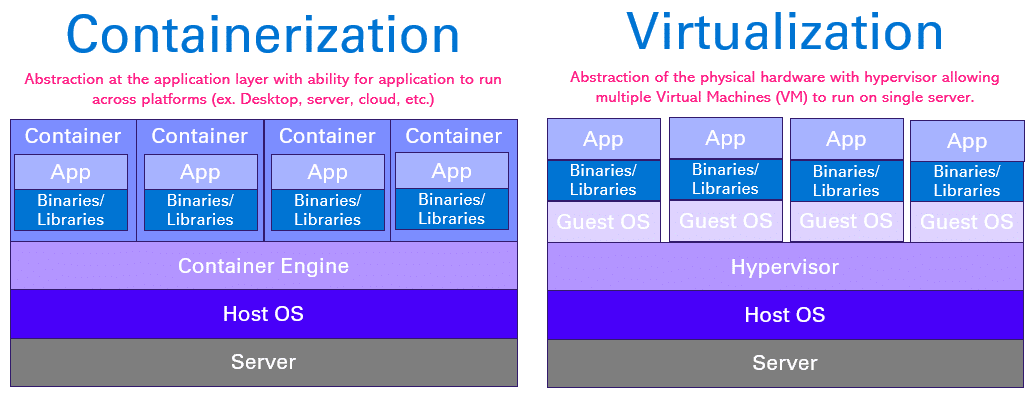Open source containerisation software provides the flexibility, cost-effectiveness, and community support needed to build and manage complex multi-cloud and hybrid cloud environments. By leveraging this software, businesses can unlock the full potential of multi-cloud and hybrid cloud architectures while minimising vendor lock-in risks.
Containerisation in the cloud is a key aspect of modern cloud computing architectures, particularly in multi-cloud and hybrid cloud environments. It involves encapsulating applications and their dependencies into lightweight, standalone units known as containers. This approach offers several benefits, including portability, fault isolation, ease of management, and simplified security.
The rise of multi-cloud and hybrid cloud architectures has dramatically reshaped the IT landscape. These models offer businesses greater flexibility, scalability, and resilience. However, they also introduce new complexities and challenges. Here, open source software emerges as a crucial enabler, providing a foundation for building and managing these intricate environments. The popularity of open source container platforms like Dockers, Kubernetes and OpenStack has led to rapid adoption of “write once and run anywhere” across on-premises data centres, hybrid cloud and multi-cloud environments. In addition to the flexibility, the architecture design speeds up development and prevents cloud vendor lock-in.
| Multi-cloud | Hybrid cloud | |
| Definition | The use of multiple cloud platforms from different providers. | A combination of on-premises infrastructure with public cloud services. |
| Benefits | Vendor independence, cost optimisation, disaster recovery, flexibility | Flexibility, cost optimisation, compliance, legacy system support |
| Challenges | Complexity, inconsistent APIs and tools, data governance | Complexity, integration, security |
| Characteristics | Ideal for businesses seeking maximum flexibility and vendor independence. | Suitable for businesses that want to gradually migrate to the cloud or maintain control over certain workloads. |
| Use cases | Ideal for large enterprises with complex IT environments and high tolerance for risk. | Well-suited for businesses with a mix of legacy systems and modern applications. |
| Example | A company using AWS for development, Azure for production, and GCP for analytics. | A company running critical applications on-premises while using the cloud for non-critical workloads or peak demand. |
Table 1: Multi-cloud vs hybrid cloud

Understanding multi-cloud and hybrid cloud
Containerisation has become a cornerstone of modern cloud computing. Its benefits, such as portability and resource efficiency, make it a game changer. Understanding containerisation involves grasping the concept of encapsulating applications and their dependencies into lightweight, standalone units known as containers. Multi-cloud and hybrid cloud are two prominent cloud computing architectures that have gained significant traction in recent years, enabling the containerisation of applications.
| Open source software | Proprietary software | |
| Cost | Typically, more affordable | Relatively more expensive |
| Flexibility | Highly customisable and adaptable | Limited flexibility and customisation |
| Community support | Strong community-driven support | Limited support from vendors |
| Interoperability | Typically designed to be interoperable with different platforms. | May be limited in interoperability. |
| Innovation | Promotes innovation through collaboration and experimentation. | Innovation is slower due to vendor control. |
| Vendor lock-in | Reduces the risk of vendor lock-in. | Can lead to vendor lock-in. |
| Control | Provides greater control over software. | Offers limited control over software. |
| Customisation | Allows for extensive customisation. | Customisation may be limited. |
| Security | Can be highly secure but requires careful management. | May have security vulnerabilities. |
| Licensing | Various licensing models available (e.g., GPL, Apache, MIT). | Typically licensed under proprietary terms. |
Table 2: Open source vs proprietary containerisation software in multi-cloud and hybrid cloud environments
Multi-cloud: This refers to the use of multiple cloud platforms from different providers, such as AWS, Azure, and GCP. It offers increased flexibility, vendor independence, and disaster recovery capabilities.
Hybrid cloud: A hybrid cloud combines on-premises infrastructure with public cloud services. This approach allows businesses to maintain control over certain workloads while leveraging the benefits of the cloud for others.
By carefully considering the factors listed in Table 1, businesses can make informed decisions about whether to adopt a multi-cloud or hybrid cloud strategy and leverage the benefits while mitigating the risks. Some additional considerations are listed below.
- Security: Both multi-cloud and hybrid cloud environments require robust security measures to protect sensitive data and prevent unauthorised access.
- Governance: Implementing effective governance frameworks is essential to manage the complexities of multi-cloud and hybrid cloud environments.
- Integration: Integrating different cloud platforms and on-premises systems can be challenging and requires careful planning.
- Cost management: Accurately tracking and managing costs across multiple cloud environments can be complex.
- Performance: Ensuring optimal performance and latency in multi-cloud and hybrid cloud environments can require careful optimisation.
The role of open source in multi-cloud and hybrid cloud architectures
Open source software containerisation platforms have become an integral component of modern IT environments, particularly in the context of multi-cloud and hybrid cloud architectures. These flexible and scalable platforms offer businesses greater agility, cost-effectiveness, and resilience and play a crucial role in the successful implementation and management of multi-cloud and hybrid cloud environments.
By providing a foundation of cost-effective, flexible, and community-supported tools, open source containerisation software empowers businesses to leverage the benefits of these innovative architectures, offering a comprehensive suite of solutions for building and operating multi-cloud and hybrid cloud environments.
As can be seen in Table 2, open source containerisation software offers significant benefits for businesses adopting multi-cloud and hybrid cloud architectures. By reducing costs, enhancing flexibility, and fostering innovation, open source technologies enable businesses to optimise their IT operations and achieve strategic goals. Open source containerisation software is highly customisable and adaptable, making it suitable for complex environments. The community-driven nature of open source development provides valuable resources and support. Additionally, open source software can help businesses reduce vendor lock-in and negotiate better terms with vendors.
Steps to follow when implementing containerisation in a multi-cloud environment
Choose a container platform: Select a container platform like Docker or Kubernetes. These platforms provide the tools needed to create, manage, and orchestrate containers.
Containerise applications: Encapsulate your applications and their dependencies into containers. This involves creating a Docker file that specifies the application’s environment and dependencies.
Use Infrastructure as Code (IaC): Tools like Terraform and Ansible can be used to define and manage infrastructure across multiple clouds.
Container orchestration: Use Kubernetes to manage containers and applications across different environments.
Configuration management: Automate configuration tasks and ensure consistency across different systems using tools like Ansible or Puppet.
Networking: Implement network virtualisation and management using tools like Open vSwitch (OVS) and Calico.
Data management: Use tools like Apache Hadoop and Apache Spark for Big Data processing and analytics.
Security: Protect applications and data in multi-cloud environments using open source security tools like OpenSCAP and OWASP ZAP.
| Virtualisation | Containerisation | |
| Pros |
|
|
| Cons |
|
|
Table 3: Pros and cons of containerisation and virtualisation
Containerisation vs virtualisation
The technology stack is similar for containerisation and virtualisation. Hence, the deployment model is largely decided based on the needs of the application’s non-functional characteristics. One way to decide is by making a checklist of the benefits and concerns of deploying each model. Table 3 outlines the pros and cons of both virtualisation and containerisation.
Open source containerisation software, a cornerstone of microservices driven architecture, is highly scalable and performs well at a fraction of the traditional or virtualisation resource costs. But it does require careful planning of architecture and design to address management and security concerns.
Disclaimer: This article expresses the views of the author and not of the organisation he works in.












































































